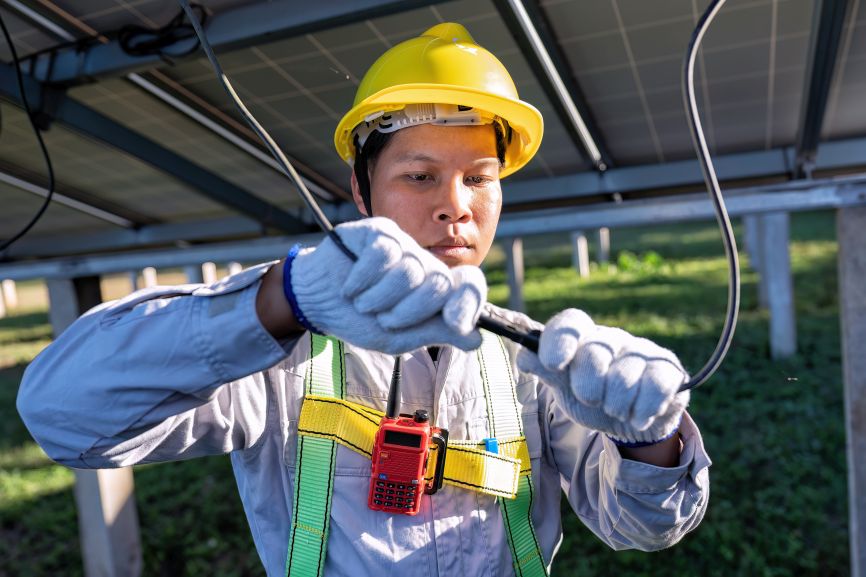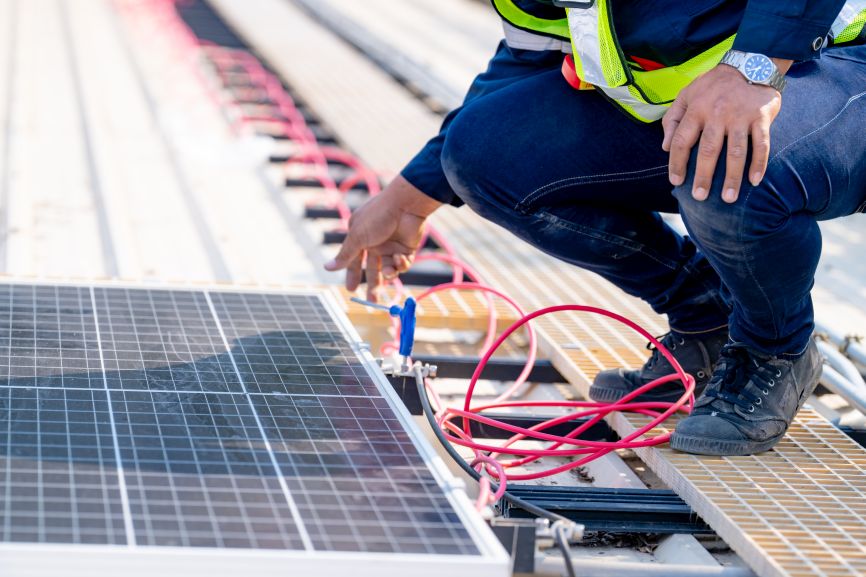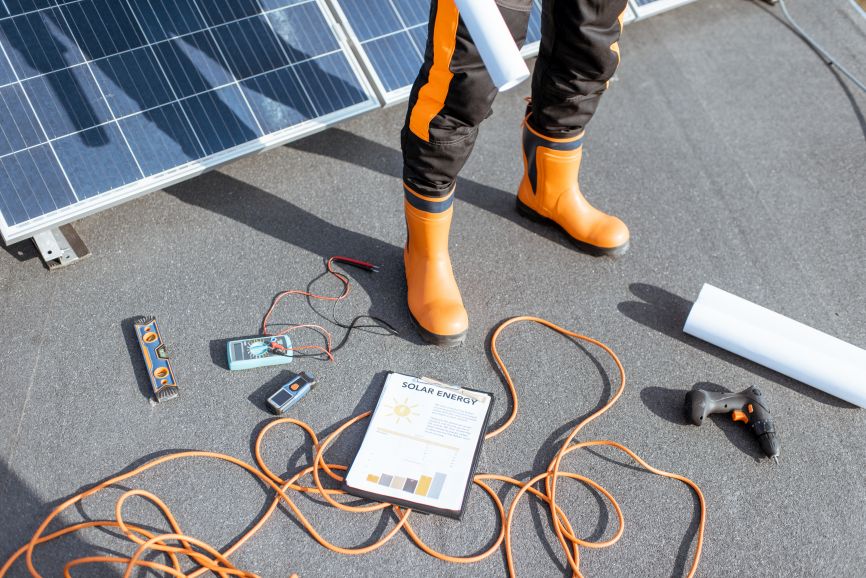Solar panel wiring is the foundation of every solar power system — and if it’s done right, your panels won’t just generate energy, they’ll deliver safe, reliable, and long-term savings for your home. Get it wrong, and you could be looking at wasted power, costly inefficiencies, or even safety risks.
Here’s the truth: your solar panels are only as strong as the wiring that connects them. Whether you choose series wiring for higher voltage, parallel wiring for reliability under shade, or a hybrid approach tied into advanced inverters, every connection matters. The way your system is wired determines how much electricity flows, how efficiently it’s converted, and ultimately how much money you keep in your pocket.
In this guide, we’ll break down everything you need to know about solar panel wiring — so you can make smart, confident choices when it comes to powering your home.

TL;DR – Solar Panel Wiring in a Nutshell
-
Series wiring = voltage adds up, great for long runs but sensitive to shading.
-
Parallel wiring = amps add up, better shade tolerance but needs thicker wires.
-
Right equipment matters: PV wire, MC4 connectors, junction/combiner boxes, and correct wire gauge keep your system efficient and safe.
-
Inverters + MPPTs: The inverter converts DC to AC, while MPPT tech squeezes maximum energy even under less-than-perfect conditions.
-
Best practices: Stay within inverter voltage limits, balance your strings, and follow NEC safety codes.
-
Bottom line: Solar panel wiring isn’t DIY guesswork — professional design ensures efficiency, safety, and decades of reliable power.
Understanding the Basics of Solar Panel Wiring
Before we dive into step-by-step setups, let’s make sure we’re speaking the same language. Solar panel wiring might sound technical, but once you understand three simple electrical terms — voltage, current, and power — the whole picture starts to click.
Key Electrical Terms You Should Know
Voltage (V)
Think of voltage as the “pressure” that pushes electricity through your solar wiring. The higher the voltage, the stronger the push. When panels are wired in series, the voltage adds up, giving your system the muscle it needs to move electricity over longer distances.
Current (A or Amps)
If voltage is pressure, current is the flow. It’s the actual volume of electrons moving through the wires. In parallel wiring, current increases while voltage stays the same — which can be useful if parts of your system face shading or different conditions.
Power (W or Watts)
Watts are where the magic happens: this is the usable energy your home appliances actually consume. It’s calculated with a simple formula: Power = Voltage × Current (P = V × A).
Bringing It Together
Imagine water flowing through a hose. Voltage is the water pressure, current is how much water flows, and power is the total amount of water delivered to your garden. The same concept applies to solar panel wiring — and once you see how these pieces fit together, wiring stops feeling like a mystery and starts looking like a system you can master.
What Wiring is Needed for Solar Panels?
You can buy the most advanced solar panels on the market — but without the right wiring, none of that power ever makes it to your lights, appliances, or EV charger. Think of wiring as the hidden highway that carries your energy. If it’s built correctly, electricity flows smoothly and efficiently. If it’s not, you’ll lose power, waste money, and possibly face serious safety risks.
Common Solar Wires and Connectors
- PV Wire: Specially designed for outdoor solar use, resistant to UV, heat, and moisture. This is the lifeline of your system.
- MC4 Connectors: Snap-lock connectors that make panel-to-panel wiring safe and weatherproof — no twisting wires or messy tape jobs.
- Junction Boxes & Combiner Boxes: Where multiple wires join together, keeping everything organized, safe, and easy to service later.
Why Wire Gauge Matters
Thicker wires (lower gauge numbers) can carry more current with less resistance. Undersized wires heat up, waste energy, and can even become fire hazards. Proper gauge selection ensures your solar system delivers every watt you’ve paid for.
NEC Safety Considerations
In the U.S., solar installations must follow the National Electrical Code (NEC). These rules exist to protect your home from shorts, overloads, and poor-quality workmanship. Professional installers size wires, fuses, and breakers according to NEC standards — so your solar panel wiring isn’t just efficient, it’s safe and compliant.
Bottom line? Solar panel wiring isn’t just about connecting dots. It’s about using the right parts, the right thickness of wire, and following proven safety codes to keep your system running strong for decades.

Series vs Parallel Solar Panel Wiring
If you’ve ever connected Christmas lights, you already know the basics of solar panel wiring. The way panels are connected — in series or in parallel — determines how power flows through your system. Get this choice right, and your solar setup runs smoothly. Get it wrong, and you’ll waste efficiency or face constant headaches.
What is Series Wiring?
In series wiring, solar panels are connected end-to-end — positive to negative, just like batteries in a flashlight.
- Voltage Adds Up: Each panel’s voltage stacks, but the current (amps) stays the same.
- Benefits: Higher voltage means electricity can travel long distances without much loss, making series wiring great for rooftop arrays where panels are grouped together.
Series wiring = efficiency in distance and simplicity in design. But remember — if one panel is shaded, the whole string suffers.
What is Parallel Wiring?
In parallel wiring, all the panel positives connect together, and all the negatives connect together — like lanes of a highway merging into a bigger road.
- Current Adds Up: Amps increase, while voltage stays the same.
- Benefits: If one panel is shaded or underperforming, the others keep producing power. This makes parallel wiring more reliable in real-world conditions where shade or dirt is unavoidable.
Parallel wiring = stability under shading, though it requires thicker wires to handle higher current.
Series vs Parallel – Which is Better?
The answer? It depends on your setup.
| Factor | Series Wiring | Parallel Wiring |
| Voltage | Adds up | Stays constant |
| Current | Stays constant | Adds up |
| Efficiency Over Distance | Excellent | Moderate |
| Shade Tolerance | Poor (one weak panel affects all) | Strong (others keep working) |
| Wire Size Needed | Thinner | Thicker |
| Inverter Compatibility | Great for high-voltage inverters | Great for low-voltage systems |
When to Use Each
- Use series wiring if your panels are evenly exposed to sun, close together, and you want higher voltage efficiency.
- Use parallel wiring if you’re dealing with shading, mixed orientations, or want maximum reliability.
- Many modern systems use a hybrid approach or microinverters, blending the best of both worlds.
How to Wire Solar Panels (Step-by-Step)
By now, you know the theory. But what does solar panel wiring look like in action? Let’s break it down so you can see exactly how series and parallel connections are made — and what mistakes to avoid along the way.
Wiring Solar Panels in Series
Step-by-Step:
- Place your panels in position, ready to connect.
- Take the positive (+) wire from the first panel and connect it to the negative (–) wire of the second panel.
- Continue linking positive to negative until all panels are connected in one chain.
- At the end of the string, you’ll have one unused positive and one unused negative wire. These connect directly to your inverter or combiner box.
Common Mistakes to Avoid:
- Mismatched Panels: Mixing different wattages or voltages in series causes the whole string to perform at the level of the weakest panel.
- Ignoring Shading: Shade on even one panel will drag down the output of the entire series string.
- Exceeding Inverter Limits: Too many panels in series can push voltage beyond the inverter’s safe range.
Wiring Solar Panels in Parallel
Step-by-Step:
- Position your panels side by side, ready to connect.
- Connect all the positive (+) wires together using a branch connector or combiner box.
- Connect all the negative (–) wires together in the same way.
- Run one combined positive and one combined negative wire into your inverter or charge controller.
Common Mistakes to Avoid:
- Undersized Wires: Remember, current adds up in parallel. Using wires that are too thin can cause overheating and energy loss.
- Skipping Fuses/Breakers: Parallel connections require overcurrent protection on each string — ignoring this is a fire risk.
- Loose Connections: MC4 connectors must snap firmly. A half-click connection can arc and damage your system.
How Solar Panel Wiring Works with Inverters

Even with perfect wiring, solar panels don’t deliver “ready-to-use” electricity straight to your home. They produce DC (direct current) power, but your home runs on AC (alternating current). That’s where the inverter comes in — the translator that makes your solar energy usable.
Understanding Inverter Basics
Role of Inverters in Wiring Systems
The inverter takes the DC electricity from your wired solar panels and converts it into AC so you can power everything from your refrigerator to your phone charger. Think of it as the heart of your solar system — pumping energy in the right format where it’s needed most.
String Inverters vs Microinverters
- String Inverter: One central device that manages a whole “string” of panels. Cost-effective and simple, but if shading or a fault affects one panel, it drags down the performance of the entire string.
- Microinverters: Small inverters installed on each individual panel. They maximize production from every panel and handle shade better, though they cost more upfront.
The type of inverter you choose shapes how your solar wiring should be designed.
What are MPPTs (Maximum Power Point Trackers)?
Here’s where things get interesting. An MPPT (Maximum Power Point Tracker) is smart technology inside your inverter that constantly adjusts voltage and current to squeeze the maximum power output from your panels.
- How MPPT Affects Wiring Efficiency: Solar panels don’t always operate at peak conditions (clouds, shade, heat). MPPT ensures your wiring setup still delivers as much usable energy as possible, even when conditions fluctuate.
- Why Multiple MPPT Inputs Matter in Design: If you have panels on different roof sections (say, east-facing and south-facing), multiple MPPTs let the inverter manage each group separately. That means one shaded panel on the east roof won’t kill the performance of your sunny south-facing panels.
Bottom line? Pairing the right wiring configuration with the right inverter (and MPPT setup) is what transforms solar from “it works” into “it saves.”
Solar Panel Wiring Rules & Best Practices
When it comes to solar panel wiring, there are a few golden rules that separate a smooth, money-saving system from one that constantly underperforms. These best practices ensure your panels, wires, and inverter all play nicely together — and keep your home powered safely for years.
Voltage & Inverter Range
Your inverter is built to handle a specific voltage window. Wire your panels so the total voltage falls within that range.
- Over-voltage: Too many panels in series can fry your inverter or trigger emergency shutdowns.
- Under-voltage: Too few panels in series, and the inverter may not even switch on.
Rule of thumb: Always check your inverter’s minimum and maximum voltage limits before finalizing your wiring plan.
Keeping Strings Balanced
Solar panels are team players — but only if each string is on a level playing field.
- Why Equal Conditions Matter: If one string of panels faces south and another faces west, combining them into one MPPT can cause energy loss.
- Shading & Orientation Issues: Shade from trees, chimneys, or dirt on a single panel can drag down the whole series string. Mismatched orientations and tilt angles cause the same problem.
Balanced strings = maximum performance. Unbalanced strings = wasted potential.
Advanced Considerations
- Inverter Clipping Explained: When your panels produce more power than the inverter can handle, the extra energy is simply cut off. This isn’t always bad — sometimes it’s a cost-saving trade-off — but it must be planned, not accidental.
- Microinverter Benefits: By giving each panel its own mini inverter, you eliminate string balance problems and shade drag-downs. Each panel works at its personal best, making microinverters a powerful (though pricier) option.
- Software Tools for String Design: Professional installers now use design software that automatically calculates string sizes, voltage limits, and shading impacts. It takes the guesswork out of solar panel wiring and ensures your system is tuned for peak performance.
Solar Panel Wiring FAQs
What wiring is required for solar panels?
Solar panels use PV wire (photovoltaic wire) designed for outdoor durability, paired with MC4 connectors for weatherproof, snap-tight connections. Junction boxes and combiner boxes organize multiple strings, while properly sized breakers and fuses protect your system.
Is it better to wire solar panels in series or parallel?
It depends. Series wiring boosts voltage and works well when all panels face the same direction with no shade. Parallel wiring keeps voltage steady and amps higher, making it better for mixed conditions or partial shading. Many modern systems blend both approaches or use microinverters for the best of both worlds.
How many solar panels can I connect to my inverter?
That depends on the inverter’s voltage and current limits. Exceeding those can cause your system to shut down or underperform. A professional design (often using software) calculates the ideal number of panels per string so your inverter runs at peak efficiency without overload.
Can I connect solar panels directly to a battery?
Technically yes, but it’s not recommended. Batteries require a charge controller to regulate voltage and prevent overcharging or damage. Skipping that step can shorten your battery’s life or create safety risks.
Can I use solar panels and an inverter without a battery?
Absolutely. In fact, most grid-tied systems don’t use batteries. Panels feed into the inverter, and excess energy goes back to the grid. Batteries are optional — they add backup power and energy independence but also extra cost.
How does solar wiring fit into a whole home electrification plan?
Solar wiring is the backbone of powering an all-electric lifestyle. From EV chargers to heat pumps, the way your system is wired determines how much energy you capture, store, and use. Proper wiring ensures you’re not just going solar, but building a home that’s future-ready and energy independent.
Key Takeaways – Wiring Solar Panels the Right Way
When it comes to solar panel wiring, every connection counts. Here’s what to remember:
- Series vs Parallel: Series wiring boosts voltage for long runs, while parallel wiring improves reliability under shading. The right choice depends on your roof and energy needs.
- Safety First: Correct wire gauge, NEC compliance, and balanced strings prevent energy loss and protect your home from hazards.
- Inverter Matching Matters: Your wiring design should fit your inverter’s voltage and current range, and MPPTs ensure you’re always squeezing maximum output from your panels.
The bottom line? Solar panel wiring isn’t a guessing game — it’s a precise science that directly affects your energy savings and safety. With professional design and installation, you get a system that’s efficient, worry-free, and built to power your home for decades.
Ready to Install Solar? Get a Free Quote Today
Solar panel wiring may sound technical, but the truth is simple: when it’s done right, your system delivers maximum efficiency, rock-solid safety, and savings that last for decades. The difference lies in choosing a team that knows how to design and wire your panels for your unique home.
Curious how much you could save with a properly designed solar system? Don’t leave it to guesswork. Request a free, no-obligation quote today and let EcoSunWorks connect you with trusted local installers who’ll do the job right the first time. Your future energy independence starts with a phone call.
